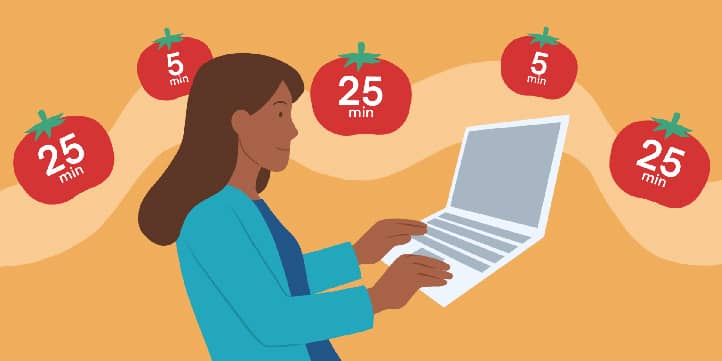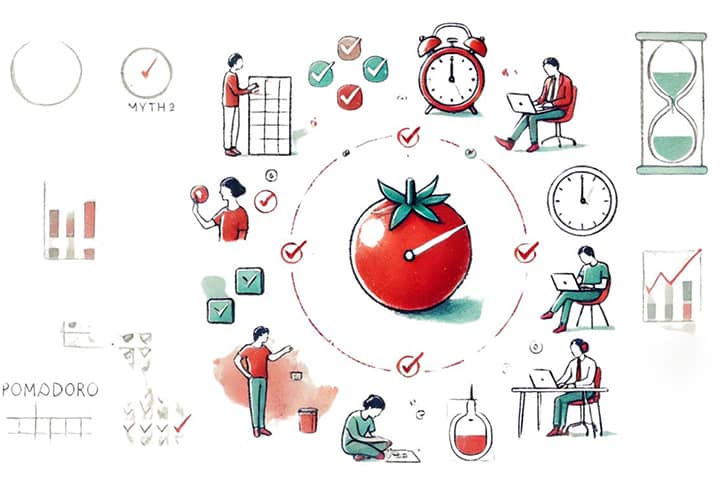In today’s world, the issue of effective time management has become particularly relevant. Every day, we face numerous tasks, deadlines, and information overload, which compels us to search for ways to increase productivity. Constant distractions, multitasking, and the lack of a clear work organization system often lead to reduced concentration, feelings of fatigue and burnout.
In such circumstances, there is an acute need for simple yet effective tools to better allocate working time and energy. This is why finding efficient time management methods has become essential for many people, regardless of their field of activity.
Against this backdrop, the Pomodoro Technique has gained widespread popularity due to its simplicity and effectiveness. Its uniqueness lies in the combination of short, intensive work intervals with regular breaks, allowing one to maintain high concentration and avoid fatigue.
Since the inception of this technique, its popularity has only grown, as it enables people not only to plan their day better but also to see tangible results after just a few attempts. In the digital age, where every minute is precious, the Pomodoro Technique has become a true breakthrough for those who seek to work more productively while maintaining a balance between work and rest.

What Is the Pomodoro Method?
The Pomodoro Technique is a simple yet highly effective time management technique that helps improve concentration, avoid fatigue, and make the work process more organized. The idea is to alternate intense work periods with short breaks, allowing the brain to stay focused and productive for extended periods. This method significantly reduces stress levels, lowers the risk of burnout, and gradually enhances self-discipline. The Pomodoro Technique is ideal for tackling both large projects and daily smaller tasks.
This technique is popular among students, freelancers, office workers, and even creative professionals, as it does not require complex tools or additional knowledge. All you need to use it is a timer and a clear understanding of what you are working on. The method’s flexibility and universality make it effective in any field where focus and systematic progress are crucial.
Origin of the Method
The Pomodoro Technique was developed in the late 1980s by Italian student Francesco Cirillo. At the time, he was studying at university and, like many other students, struggled with concentration and efficient time allocation while preparing for exams. One day, he decided to use a kitchen timer shaped like a tomato to organize his study process. Francesco set the timer for 25 minutes and promised himself to work without interruptions until the timer rang. Afterward, he took a short break and repeated the cycle. This approach turned out to be so effective that Cirillo developed a comprehensive technique, which he called the “Pomodoro Method” (from the Italian word pomodoro—”tomato”).
Later, Francesco detailed this technique in his book The Pomodoro Technique, explaining how to use the method correctly to achieve maximum results. His idea quickly gained popularity in various professional circles because it required no complicated resources, and its principles could easily be integrated into daily workflows.
The Essence of the Technique
The core principle of the Pomodoro Technique is to divide the work process into short but focused intervals of 25 minutes, called “Pomodoros.” Each of these intervals is dedicated to completing a specific task without any distractions. After each work block, there is a short 5-minute break, during which it is recommended to completely step away from work—stand up, take a walk, stretch, or drink some water. After four such cycles (approximately two hours of work), a longer break of 15–30 minutes is needed for a full recovery.
A key aspect of this technique is complete concentration during each 25-minute interval. During this time, all sources of distraction must be eliminated: notifications on the phone should be turned off, unnecessary browser tabs closed, and those around you informed of your focus.
This approach helps maintain high energy levels, complete tasks more efficiently, stay focused for extended periods, and avoid exhaustion. It creates a balance between intense work and rest, promoting steady progress even on the most complex and large-scale projects. Over time, the method helps users better understand their own work rhythms and effectively plan their day.

The Core Principles of the Pomodoro Technique
The Pomodoro Technique is based on a structured approach to work, designed to help organize time and maintain high productivity throughout the day. The key idea of this technique is to balance intensive work sessions with regular breaks. This approach prevents burnout, maintains focus, and enables steady progress, even with the most complex tasks. Thanks to its simple yet effective rules, the Pomodoro Technique becomes a universal tool for time management.
This technique combines several key elements that work together to create a sustainable system. It’s essential not only to allocate time for work and rest effectively but also to adhere to clear planning rules, avoid distractions, and maintain a steady rhythm. Following these principles ensures the maximum effectiveness of the Pomodoro Technique.
Clear Task Planning
The effectiveness of the Pomodoro Technique begins with proper planning. Before starting work, it is crucial to clearly identify the tasks you will focus on. Large projects should be broken down into smaller tasks that can be completed within one or several 25-minute intervals. This approach helps avoid feelings of overwhelm and enables gradual progress toward the goal.
Planning also involves prioritizing tasks. It is best to begin with the most important and challenging tasks when your energy level is at its peak. Using to-do lists, where all tasks for the day are clearly outlined, can be helpful. It’s important to remain realistic and plan only as much work as can be completed without overloading yourself.
Work Without Distractions
One of the key principles of the Pomodoro Technique is eliminating distractions during work intervals. Throughout each 25-minute session, you must focus exclusively on the selected task. This means turning off phone notifications, closing unnecessary browser tabs, and informing colleagues or family members about your unavailability.
To manage internal distractions, such as spontaneous thoughts or the urge to check social media, Francesco Cirillo suggested using a “distraction sheet.” When a distracting thought arises, jot it down on a separate sheet and return to work. This practice helps maintain focus without losing valuable ideas.
Regular Short Breaks (5 Minutes)
After each 25-minute work interval, a short 5-minute break is mandatory. These pauses are crucial for allowing the brain to rest and prepare for the next work block. During the break, it’s important to completely detach from work—stand up, stretch, take a few deep breaths, or drink some water.
These brief pauses help reduce mental fatigue, improve blood circulation, and sustain a high level of concentration. It’s vital not to spend this time scrolling through social media or checking emails, as these activities can place additional strain on the brain and reduce work efficiency.
Long Break After Four Cycles (15–30 Minutes)
After completing four full work cycles (roughly two hours of work), take a long break lasting 15–30 minutes. This pause allows for deeper energy recovery and stress relief. During this time, it is recommended to completely disconnect from work-related tasks and engage in something enjoyable and relaxing. This could include a walk outdoors, light physical activity, meditation or simply resting quietly.
Long breaks help replenish cognitive resources and prevent burnout. They allow you to return to work with renewed energy, maintaining high productivity throughout the day. Ignoring this principle diminishes the effectiveness of the Pomodoro Technique, as the body does not receive enough time to recover.
Adhering to the core principles of the Pomodoro Technique is the key to boosting personal productivity and managing time effectively. Clear task planning, maximum focus during work, regular short breaks, and longer pauses after several cycles create the perfect balance between work and rest. This system not only helps accomplish more in less time but also preserves energy and motivation in the long run.

How to Apply the Pomodoro Technique Correctly?
The Pomodoro Technique is renowned for its simplicity and accessibility, but achieving maximum results requires proper application. This method is suitable for people in various fields—from students to entrepreneurs—because it enables effective time management, helps avoid procrastination, and maintains focus. To fully harness its potential, it’s crucial to follow a clear set of instructions and use the right tools for organizing your workflow.
Proper implementation of the Pomodoro Technique helps structure your day and manage tasks more efficiently. It not only boosts productivity but also reduces stress levels, as large tasks are broken down into small, manageable parts. Additional tools such as timers, specialized apps, and trackers make the process even more convenient and help monitor progress.
Step-by-Step Instructions
To apply the Pomodoro Technique effectively, follow these steps:
- Define Your Tasks. Before starting, determine a specific task or list of tasks to complete. Ensure these tasks are clearly defined and realistic. Large projects should be divided into smaller subtasks, each of which can be accomplished within one or several 25-minute cycles.
- Set a Timer for 25 Minutes. Choose a timer or a specialized app and set it for 25 minutes. During this time, work with maximum focus, avoiding any distractions. If spontaneous thoughts or ideas arise, jot them down, but do not divert your attention from the task.
- Work Until the Timer Rings. Stay focused on one task throughout the interval. Avoid switching between tasks or checking messages or social media. This trains your ability to engage in deep work.
- Take a Short Break (5 Minutes). After completing 25 minutes of work, take a short break. Step away from your computer or workspace, do light exercises, drink water, or get some fresh air. The key is to detach from mental activity.
- Repeat the Cycle. Perform three more cycles of work, each followed by a short break. In total, this constitutes four full 25-minute work blocks.
- Take a Long Break (15–30 Minutes). After four work cycles, take a long break. Use this time to rest completely—go for a walk, listen to music, or do physical exercises. This break helps you fully recharge for the next session.
- Repeat as Needed. After the long break, you can start a new Pomodoro cycle if there are unfinished tasks or new goals to tackle.
Tools for Implementation
To make the Pomodoro Technique more convenient, numerous tools help organize work and track task completion.
- Mechanical and Digital Timers
The classic option is to use a regular kitchen timer or alarm clock. Its advantage is simplicity and the absence of distracting features. You can also use a built-in timer on your phone or computer. - Mobile Apps
Today, many smartphone apps automate the Pomodoro process. Here are some popular ones:- Forest: An app that helps avoid distractions by growing virtual trees during work.
- Focus Plant: Offers a simple interface with a timer and tracking options.
- Pomodoro Timer: A classic timer with settings for work and break intervals.
- Online Services
For those working on a computer, online timers that don’t require software installation are convenient:- TomatoTimer: A straightforward web service with a Pomodoro timer.
- Pomofocus: An interactive site that allows you to track tasks and automatically switch between work and break phases.
- Productivity Trackers
To monitor work efficiency, use trackers that collect statistics on completed cycles and time spent. These tools help analyze productivity and better plan workdays. Popular services include:- Toggl Track: Convenient for time tracking with integration into workflows.
- RescueTime: Analyzes how time is spent on the computer and helps avoid distractions.
Properly selected tools make the Pomodoro Technique even more effective, allowing you to automate the process, track progress, and maintain motivation. Everyone can choose the tools that best suit their needs and working style.
Following the step-by-step instructions of the Pomodoro Technique and using convenient tools not only increases productivity but also teaches you to plan your time better. Regular practice of this technique develops skills in concentration, self-discipline, and effective energy management. As a result, the Pomodoro Technique becomes a reliable ally in achieving goals and maintaining a balance between work and rest.

Advantages of the Pomodoro Technique
The Pomodoro Technique has gained popularity due to its simplicity and effectiveness. It doesn’t require complex tools or special knowledge, yet it significantly impacts productivity and work quality. This technique helps focus on specific tasks, avoid burnout, and better manage time. By using the Pomodoro Technique, a person works more mindfully, learns to plan their day, and gradually achieves even ambitious goals.
Regular practice of this technique creates favorable conditions for stable personal and professional development. It promotes the formation of beneficial habits that help maintain a balance between work and rest, as well as avoid emotional burnout. Due to its advantages, the Pomodoro Technique is a universal tool for people in any profession and lifestyle.
Increased Focus and Productivity
One of the main benefits of the Pomodoro Technique is the significant increase in focus. The 25-minute work blocks allow you to focus on one task without distractions. Thanks to clear time frames, the brain is set for intense work, which helps immerse in the process and increases efficiency.
This approach helps avoid procrastination and eliminate multitasking, which often reduces task quality. Short work intervals help stay focused because a person knows they only need to work for a set period, after which there will be a break. This motivates working as efficiently as possible within each cycle.
Moreover, the Pomodoro Technique helps better assess the amount of work. When tasks are broken down into specific blocks, their implementation seems easier and more achievable. This allows you to work with more confidence and minimizes the risk of unfinished tasks.
Reduced Fatigue and Burnout Prevention
Regular short breaks after each 25-minute cycle help reduce fatigue. The body gets a chance to recover and avoid overload. Unlike long periods of uninterrupted work, the Pomodoro Technique ensures a balance between active work and rest, allowing you to maintain high energy levels throughout the day.
Longer breaks after four work blocks (15–30 minutes) help avoid chronic fatigue and emotional exhaustion. These pauses allow the body and mind to fully rest, serving as an effective means of preventing professional burnout. This gives time for relaxation, which helps maintain emotional balance and increases overall satisfaction with work.
The Pomodoro Technique helps recognize your physical and emotional limits, preventing overload. This promotes motivation, reduces stress and anxiety levels, and positively impacts mental health. As a result, work becomes not only more efficient but also more comfortable.
Improved Time Management Skills
The Pomodoro Technique develops effective planning and time management skills. Work blocks and breaks form a clear structure for the day, helping to better allocate tasks and avoid chaotic work. Through this technique, a person learns to realistically estimate how much time a specific task will take and plans their day accordingly.
Tracking completed Pomodoros helps monitor progress and adjust time allocation. This helps understand which tasks take more time and allows for timely changes to the schedule. This approach improves discipline, helps avoid procrastination, and prevents spending time on less important tasks.
Additionally, the Pomodoro Technique encourages self-control. Working in clearly defined intervals teaches consistency, reduces the likelihood of procrastination, and fosters responsibility for one’s time. This is particularly useful for individuals working remotely or independently planning their workday.
Implementing the Pomodoro Technique into daily practice helps achieve goals faster and more easily while maintaining mental and physical health. It is a universal approach that suits any field of activity and helps achieve stable results without unnecessary stress.

Possible Challenges and How to Overcome Them
Although the Pomodoro technique is a fairly simple and effective productivity tool, its implementation can be accompanied by certain challenges. This is entirely natural, especially for those who are just beginning to use this method. Some people encounter difficulties due to issues with concentration, not following the timing, or an inability to plan tasks properly. However, understanding these challenges and finding ways to address them can help make the Pomodoro technique as effective as possible.
It is important to realize that the method requires some adaptation to individual characteristics. Everyone may face different challenges, but these issues can be resolved through practical advice and gradual improvements in how work is organized.
Distractions During Work
One of the most common problems when using the Pomodoro technique is distractions. In an environment of constant information flow from social networks, messengers, and other sources, focusing on a single task can be challenging. Random calls, messages, or noise around you can easily interrupt your workflow, reducing concentration and efficiency.
How to avoid:
- Turn off notifications. During the work interval, it is recommended to disable notifications on your phone and computer or use “Do Not Disturb” mode. This will help minimize the impact of external factors.
- Organize your workspace. It is important to create a comfortable and quiet work environment. Removing unnecessary items from your desk and using headphones with white noise or calming music can help maintain focus.
- Write down distracting thoughts. If unrelated thoughts or ideas come up during work, it’s better to jot them down in a notebook and return to them during a break. This allows you to preserve important information without interrupting your workflow.
- Make arrangements with others. If you work from home or in an office, agree with colleagues or family members not to disturb you during work. For example, you can use a “Do Not Disturb” sign.
Difficulties in Following the Timing
Some people find it challenging to strictly adhere to the set 25-minute work interval or to take regular breaks. This can be due to either being overly engrossed in work or hesitating to start complex tasks. In both cases, breaking the timing reduces the method’s effectiveness.
How to avoid:
- Automated timers. Using special apps or timers that automatically signal the end of a work block and the start of a break will help maintain the rhythm.
- Gradual adaptation. If working for 25 minutes without interruption is difficult, start with shorter intervals (e.g., 15–20 minutes) and gradually increase them to the standard 25.
- Break reminders. People who get absorbed in work may forget to take breaks. Setting up reminders to signal break times can help.
- Clear task segmentation. It’s important to divide large projects into smaller tasks that can realistically be completed in one cycle. This allows better time control and prevents exceeding the set limits.
Inability to Plan Tasks Properly
Another common problem is the inability to clearly formulate tasks and prioritize them. Without a clear work plan, the Pomodoro technique may lose its effectiveness, as time will be used inefficiently.
How to avoid:
- Create a task list. Each day before starting work, write down a list of tasks to be completed, dividing them into priority and secondary tasks. This helps clarify what needs to be done first.
- Break down large tasks into subtasks. Large projects often seem overwhelming. By breaking them into smaller steps, they become easier to complete gradually. For example, instead of the task “Write a report,” write “Collect data,” “Create a structure,” and “Write the introduction.”
- Estimate task durations. After dividing tasks, determine how many “Pomodoros” will be needed for each one. This will help plan the day better and avoid overloading.
- Flexibility in planning. Plans should be realistic and allow for adjustments. If unforeseen circumstances arise, tasks can be rescheduled or reprioritized.
Despite the simplicity of the Pomodoro technique, its effectiveness depends on the ability to avoid common challenges. Distractions, timing issues, and improper planning can reduce productivity and affect the final outcome. However, with simple solutions such as eliminating sources of distractions, automating timing, and effectively planning tasks, these challenges can be successfully overcome.

The Pomodoro Technique for Different Fields of Activity
The Pomodoro Technique is a versatile tool that can be successfully adapted to any field of activity. Its flexibility allows you to customize work intervals to suit specific tasks, making it useful for students, freelancers, and office workers alike. The main advantage of the method lies in its ability to help better allocate time, enhance focus, and effectively achieve goals.
Each professional or educational activity presents its own challenges, which the Pomodoro Technique helps to overcome. For instance, students often face a large amount of information, freelancers deal with independent planning of their workdays, and office workers are frequently distracted. Proper use of Pomodoro allows each of these groups to optimize their workflows and avoid burnout.
For Students: Effective Exam Preparation
Students often need to study large amounts of material in a limited time, which can lead to stress and fatigue. The Pomodoro Technique helps structure the learning process, break exam preparation into logical steps, and avoid chaotic cramming.
How to apply:
- Divide material into blocks. Break down a large volume of information into separate topics or sections, studying each during one or more “Pomodoros.” For example, one 25-minute cycle can be devoted to studying theory, and the next to practicing tasks.
- Alternate types of activities. It’s essential to vary the types of work: alternate reading, note-taking, problem-solving, and reviewing material. This helps absorb information better and avoids monotony.
- Use breaks to consolidate knowledge. Short breaks can be used for active rest (light exercise, fresh air), while longer ones can be used for reviewing notes or self-testing.
This approach allows students to improve focus, avoid overload, and prepare more effectively for exams.
For Freelancers: Balancing Workloads
Freelancers often plan their own work schedules, which can lead to uneven workload distribution or procrastination. The Pomodoro Technique helps freelancers organize their tasks and clearly separate work from personal life.
How to apply:
- Plan the workday. At the beginning of the day, freelancers should make a task list and estimate how many “Pomodoros” each will require. This allows for a realistic assessment of workload and prevents overloading.
- Categorize tasks by type. Different types of tasks (e.g., creative tasks, technical tasks, client communication) are best tackled in separate work blocks. This helps maintain focus and effectively switch between activities.
- Maintain schedule flexibility. If urgent matters arise, the Pomodoro Technique allows for easy adjustments to the schedule without compromising productivity.
This approach helps freelancers distribute workloads rationally, avoid stress, and maintain a balance between work and personal life.
For Office Workers: Task Focus
Office workers often face numerous distractions: phone calls, emails, and urgent assignments from management. This makes it difficult to concentrate on important tasks and leads to reduced productivity. The Pomodoro Technique helps better organize workflows and focus on key tasks.
How to apply:
- Prioritize tasks. At the start of the day, office workers can create a prioritized task list and plan their execution within “Pomodoros.” The most important tasks should be completed in the first work blocks when energy levels are highest.
- Minimize distractions. During work cycles, it’s important to reduce distractions: turn off notifications, close unnecessary browser tabs, and agree with colleagues on times when you shouldn’t be disturbed.
- Take regular breaks. Short pauses help avoid fatigue, while longer breaks can be used for non-urgent matters (checking emails, chatting with colleagues).
This enables office workers to effectively complete tasks without wasting time on secondary matters and maintain high productivity levels throughout the workday.
The Pomodoro Technique is a universal tool for organizing work across different fields of activity. For students, it becomes an effective way to prepare for exams, helping them absorb material better and avoid fatigue. Freelancers benefit from this technique by efficiently managing workloads and avoiding procrastination. Office workers, on the other hand, can focus on important tasks and boost overall productivity with Pomodoro.

Tips for Maximum Efficiency
The Pomodoro Technique is an incredibly flexible time management tool, but its effectiveness increases significantly when you adapt the technique to your own needs and combine it with other time management methods. The universality of Pomodoro allows it to be applied in various fields, but each person has individual working characteristics that require customizing the technique to fit their style.
Additionally, integrating Pomodoro with other proven time management techniques can amplify results, enabling not only efficient work but also achieving a balance between productivity and rest. This approach provides a comprehensive framework for organizing work and achieving goals with less effort.
How to Adapt the Technique to Your Needs?
Although the classic Pomodoro Technique involves working in 25-minute blocks with 5-minute breaks, this is not a rigid rule. It is essential to consider individual characteristics, task types, and concentration levels to tailor the technique to your own working style.
Customizing Session Durations:
- Adjusting work block durations: If a task requires deep concentration, you can extend work sessions to 40–50 minutes with longer breaks. For simpler or routine tasks, shorter blocks of 15–20 minutes may be more effective.
- Analyzing peak productivity: Take your natural rhythms into account—some people work better in the morning, while others are more productive in the evening. During your most productive hours, schedule complex tasks and use longer “Pomodoros.”
- Adapting to activity types: For creative tasks (writing, design development), more flexible intervals may work better, while technical work or studying is often best suited to the classic 25-minute blocks.
A Flexible Approach to Planning:
- Additional breaks when necessary: If you feel tired or lose focus, don’t strictly adhere to the schedule—take an extra short break instead.
- Combining tasks: Group small tasks into one block or, conversely, break complex tasks into several “Pomodoros” for phased completion.
- Testing and adjusting: Experiment with the duration of blocks and breaks to find your optimal working rhythm.
Combining with Other Time Management Techniques
Integrating the Pomodoro Technique with other time management strategies can significantly enhance work efficiency. The synergy of different techniques helps you better plan your day, prioritize tasks, and avoid overload.
Eisenhower Matrix Technique:
- Task prioritization: Use the Eisenhower Matrix to divide tasks by urgency and importance. Important and urgent tasks are tackled in the first “Pomodoros,” while less critical tasks are deferred to the latter part of the day.
- Reducing non-essential tasks: The method helps minimize distractions from secondary tasks, enabling better focus on the main priorities.
GTD (Getting Things Done) Method:
- Task organization: Pomodoro integrates seamlessly with the GTD system, where all tasks are recorded, sorted by contexts, and progressively completed.
- Action-focused execution: The method allows you to effectively break large projects into actionable steps and complete them in work blocks.
“Eat That Frog” Technique:
- Tackling difficult tasks in the morning: The Pomodoro Technique is ideal for addressing the toughest and most unpleasant tasks at the start of the day when energy is at its highest.
- Clear prioritization: By dividing work into blocks, you can plan morning “Pomodoros” for the most important tasks, leaving less critical ones for later in the day.
“Time Blocking” Technique:
- Daily planning in blocks: Pomodoro pairs well with time blocking, where the entire day is divided into large blocks for specific activities. Within these blocks, “Pomodoros” can be used for detailed task management.
- Avoiding overload: Clear time allocation helps prevent chaotic task execution and better control workload.
SMART Goals Technique:
- Clear task formulation: Each “Pomodoro” can be dedicated to specific SMART goals, making task execution more deliberate and structured.
To achieve maximum efficiency, it is essential to tailor the Pomodoro Technique to your own working style, considering individual needs and task specifics. Adjusting block durations, alternating activity types, and adopting a flexible planning approach help make work comfortable and productive.
Combining Pomodoro with other time management techniques allows for comprehensive organization of the work process, effective prioritization, and goal achievement without overload. This approach helps balance productivity and rest, ensuring steady progress and high energy levels throughout the day.

Conclusions
The Pomodoro Technique is not just another time management technique—it’s a powerful tool that optimizes work, enhances focus, and conserves energy throughout the day. Its simplicity and flexibility make it accessible for use in any field.
This is an ideal choice for anyone looking to boost their productivity without compromising their health or emotional well-being. By focusing on clear work blocks, breaks, and proper planning, you can significantly improve work quality and achieve goals with less time investment.
The Pomodoro Technique not only enables more efficient work but also promotes harmony between work and rest, ensuring a necessary balance. It is important to remember that everyone has their unique working style, so the method should be adapted to individual needs and preferences. Adjusting block durations, combining with other techniques, and regularly refining approaches will help you get the most out of this strategy.
So why not try the Pomodoro Technique today? Start small: set a timer for 25 minutes and focus on an important task, then take a short break. After a few cycles, you’ll notice your productivity increasing while distractions and procrastination diminish.
Once you see the results, you’ll understand how beneficial this method can be in your life, perhaps making it the foundation of your daily routine. The Pomodoro Technique is accessible to everyone, and its effectiveness can be felt after just a few attempts.




